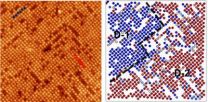Overweight and obese preschoolers lose more weight when parent is also treated
Parent involvement in the primary care setting results in sustained weight loss for parent and child; parents had an average 14-pound loss
2014-07-24
(Press-News.org) BUFFALO, N.Y. – Primary care treatment of overweight and obese preschoolers works better when treatment targets both parent and child compared to when only the child is targeted, according to research published this week in Pediatrics and conducted at the University at Buffalo and Women and Children's Hospital of Buffalo.
Children enrolled in this study were overweight or obese and had one parent who participated in the study who also was overweight or obese, according to body mass index (BMI) measurements, calculated based on height and weight.
During the course of the study, children who were treated concurrently with a parent experienced more appropriate weight gain while growing normally in height. Children in the intervention group gained an average of 12 pounds over 24 months compared to children in the control group who gained almost 16 pounds. This more appropriate weight accrual resulted in a decrease of 0.21 percent over BMI from baseline to 24 months.
Parents in the intervention group lost an average of 14 pounds, resulting in a BMI decrease of over 2 units while the weight of parents in the control group was essentially unchanged.
"Our results show that the traditional approach to overweight prevention and treatment focusing only on the child is obsolete," says Teresa A. Quattrin, MD, senior author and UB Distinguished Professor, chair of the Department of Pediatrics in the School of Medicine and Biomedical Sciences and pediatrician-in-chief at Women and Children's Hospital of Buffalo.
"This study is important because while we know that it is critical to begin treating overweight or obese children early, there has been limited data on what works best in preschool-aged children," she says.
The research was part of Buffalo Healthy Tots, a novel family-based, weight control intervention in preschool children that Quattrin directed in urban and suburban pediatric practices in Western New York.
When funded in 2010 with a $2.6 million grant by the National Institutes of Health, Buffalo Healthy Tots was the first of its kind in the U.S. The goal was to compare traditional approaches where only the child is treated to family-based, behavioral treatment implemented in pediatric primary care practices.
The study of 96 children ages 2–5 found that when overweight and obese youth and their parents were treated in a primary care setting with behavioral intervention, parents and children experienced greater decreases in body mass index (BMI) than did the children who received the traditional treatment, focusing only on the child. Weight loss for both parent and child was sustained after a 12-month followup.
Quattrin notes that an important feature of the study was the use of practice enhancement assistants, trained in psychology, nutrition or exercise science. These assistants worked with the families both during treatment and education sessions and afterward by phone.
The intervention was delivered through the parents, who were instructed about the appropriate number of food servings for children and appropriate calorie values. They were taught to avoid "high-energy" foods, such as those with high sugar content, more than 5 grams of fat per serving or artificial sweeteners.
Parents monitored the number of servings in each food category, using a simple diary to cross off icons pertaining to the food consumed or type of physical activity performed. Parents also were taught to record their own and their child's weight on a simple graph.
Weight loss goals for children were 0.5 to 1 pound per week and for parents it was at least 1 pound per week.
Quattrin says that the study results suggest that overweight or obese children and their parents can be successfully treated in the primary care setting with the assistance of practice enhancers.
"Instead of the more traditional approach of referring these patients to a specialty clinic, the patient-centered medical home in the pediatrician's office may be an ideal setting for implementing these family-based treatments," she says.
"We have entered a new era where students, trainees and specialists have to learn how to better interact with primary care providers and implement care coordination. This paper suggests that, indeed, family-based strategies for any chronic disorder, including obesity, can be successful in primary care. The pediatrician's office can become a 'family-centered medical home.' "
INFORMATION:
In addition to Quattrin, other co-authors are Leonard H. Epstein, PhD, SUNY Distinguished Professor, Michelle A. Ecker, RD, CDE and Rocco Paluch, all of the UB Department of Pediatrics; James N. Roemmich, PhD, of the UB Department of Pediatrics and the USDA/ARS Grand Forks Human Nutrition Research Center; and Jihnhee Yu, PhD, of the UB Department of Biostatistics.
ELSE PRESS RELEASES FROM THIS DATE:
NYSCF scientists one step closer to cell therapy for multiple sclerosis patients
2014-07-24
NEW YORK, NY (July 24, 2014) – Scientists at The New York Stem Cell Foundation (NYSCF) Research Institute are one step closer to creating a viable cell replacement therapy for multiple sclerosis from a patient's own cells.
For the first time, NYSCF scientists generated induced pluripotent stem (iPS) cells lines from skin samples of patients with primary progressive multiple sclerosis and further, they developed an accelerated protocol to induce these stem cells into becoming oligodendrocytes, the myelin-forming cells of the central nervous system implicated in multiple ...
Study indicates large raptors in Africa used for bushmeat
2014-07-24
Bushmeat, the use of native animal species for food or commercial food sale, has been heavily documented to be a significant factor in the decline of many species of primates and other mammals. However, a new study indicates that more than half of the species being consumed are birds, particularly large birds like raptors and hornbills.
"By surveying not only the meat made available for sale but the meat that is being eaten inside the forest by hunters and brought to villages for consumption, we noted a significant percentage attributed to bird species," said Bethan ...
New study draws links between wildlife loss and social conflicts
2014-07-24
Citing many sobering examples of how wildlife loss leads to conflict among people around the world, a new article co-authored by Wildlife Conservation Society (WCS) Health & Ecosystems: Analysis of Linkages (HEAL) Program Director Dr. Christopher Golden, calls for an interdisciplinary approach to tackle global biodiversity decline.
The harvest of wild animals directly supports about 15% of the world's people and provides protein for more than a billion of the world's poor. It should come as no surprise that today's unprecedented loss of wildlife, is bringing with it ...
Hubble finds 3 surprisingly dry exoplanets
2014-07-24
Astronomers using NASA's Hubble Space Telescope have gone looking for water vapor in the atmospheres of three planets orbiting stars similar to the sun -- and have come up nearly dry.
The three planets, known as HD 189733b, HD 209458b, and WASP-12b, are between 60 and 900 light-years away from Earth and were thought to be ideal candidates for detecting water vapor in their atmospheres because of their high temperatures where water turns into a measurable vapor.
These so-called "hot Jupiters" are so close to their star they have temperatures between 1,500 and 4,000 degrees ...
The microbes make the sake brewery
2014-07-24
A sake brewery has its own microbial terroir, meaning the microbial populations found on surfaces in the facility resemble those found in the product, creating the final flavor according to research published ahead of print in the journal Applied and Environmental Microbiology. This is the first time investigators have taken a microbial census of a sake brewery.
Many sake makers inoculate with both bacteria and yeast, says corresponding author David A. Mills of the University of California, Davis, but he and his colleagues investigated a sake brewery where inoculation ...
New imaging agent provides better picture of the gut
2014-07-24
MADISON — A multi-institutional team of researchers has developed a new nanoscale agent for imaging the gastrointestinal (GI) tract. This safe, noninvasive method for assessing the function and properties of the GI tract in real time could lead to better diagnosis and treatment of gut diseases.
Illnesses such as small bowel bacterial overgrowth, irritable bowel syndrome and inflammatory bowel disease all occur in the intestine and can lead to serious side effects in patients with diseases such as diabetes and Parkinson's.
Until now, there hasn't been a good way to ...
Brain's dynamic duel underlies win-win choices
2014-07-24
People choosing between two or more equally positive outcomes experience paradoxical feelings of pleasure and anxiety, feelings associated with activity in different regions of the brain, according to research led by Amitai Shenhav, an associate research scholar at the Princeton Neuroscience Institute at Princeton University.
In one experiment, 42 people rated the desirability of more than 300 products using an auction-like procedure. Then they looked at images of paired products with different or similar values and were asked to choose between them. Their brain activity ...
TGen-led study seeks to understand why some HIV-positive men are more infectious
2014-07-24
FLAGSTAFF, Ariz. — July 24, 2014 — A new study led by the Translational Genomics Research Institute (TGen) provides insights into the interplay among bacteria, viruses and the immune system during HIV infection.
Currently, doctors measure HIV-positive men's infectivity — their potential to infect others — based on their blood viral load. However, some men produce large amounts of virus in their semen despite having low levels in their blood. Researchers call this "compartmentalization," where different levels of the virus can be found in different parts of the body; in ...
Parched West is using up underground water, UCI, NASA find
2014-07-24
Irvine, Calif., July 24, 2014 — A new study by University of California, Irvine and NASA scientists finds more than 75 percent of the water loss in the drought-stricken Colorado River Basin since late 2004 came from underground resources. The extent of groundwater loss may pose a greater threat to the water supply of the western United States than previously thought.
This study is the first to quantify the amount that groundwater contributes to the water needs of western states. According to the U.S. Bureau of Reclamation, the federal water management agency, the basin ...
ORNL study reveals new characteristics of complex oxide surfaces
2014-07-24
OAK RIDGE, Tenn., July 24, 2014 -- A novel combination of microscopy and data processing has given researchers at the Department of Energy's Oak Ridge National Laboratory an unprecedented look at the surface of a material known for its unusual physical and electrochemical properties.
The research team led by ORNL's Zheng Gai examined how oxygen affects the surface of a perovskite manganite, a complex material that exhibits dramatic magnetic and electronic behavior. The new avenue to understand surface behavior could benefit researchers who are interested in using a wide ...
LAST 30 PRESS RELEASES:
Personalised “cocktails” of antibiotics, probiotics and prebiotics hold great promise in treating a common form of irritable bowel syndrome, pilot study finds
Experts developing immune-enhancing therapies to target tuberculosis
Making transfusion-transmitted malaria in Europe a thing of the past
Experts developing way to harness Nobel Prize winning CRISPR technology to deal with antimicrobial resistance (AMR)
CRISPR is promising to tackle antimicrobial resistance, but remember bacteria can fight back
Ancient Maya blessed their ballcourts
Curran named Fellow of SAE, ASME
Computer scientists unveil novel attacks on cybersecurity
Florida International University graduate student selected for inaugural IDEA2 public policy fellowship
Gene linked to epilepsy, autism decoded in new study
OHSU study finds big jump in addiction treatment at community health clinics
Location, location, location
Getting dynamic information from static snapshots
Food insecurity is significant among inhabitants of the region affected by the Belo Monte dam in Brazil
The Society of Thoracic Surgeons launches new valve surgery risk calculators
Component of keto diet plus immunotherapy may reduce prostate cancer
New circuit boards can be repeatedly recycled
Blood test finds knee osteoarthritis up to eight years before it appears on x-rays
April research news from the Ecological Society of America
Antimicrobial resistance crisis: “Antibiotics are not magic bullets”
Florida dolphin found with highly pathogenic avian flu: Report
Barcodes expand range of high-resolution sensor
DOE Under Secretary for Science and Innovation visits Jefferson Lab
Research expo highlights student and faculty creativity
Imaging technique shows new details of peptide structures
MD Anderson and RUSH unveil RUSH MD Anderson Cancer Center
Tomography-based digital twins of Nd-Fe-b magnets
People with rare longevity mutation may also be protected from cardiovascular disease
Mobile device location data is already used by private companies, so why not for studying human-wildlife interactions, scientists ask
Test reveals mice think like babies
[Press-News.org] Overweight and obese preschoolers lose more weight when parent is also treatedParent involvement in the primary care setting results in sustained weight loss for parent and child; parents had an average 14-pound loss




